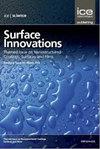Leidenfrost instability in a circular container and its suppression using a rod
IF 3.5
4区 材料科学
Q3 CHEMISTRY, PHYSICAL
引用次数: 0
Abstract
Leidenfrost drops have demonstrated promising applications in, for example, drag reduction. However, large Leidenfrost drops may be unstable when their diameters exceed a critical value, leading to less control of such drops in their applications. In this work, through theoretical and experimental investigations, we explore the instability of a Leidenfrost drop in a circular configuration, as well as the suppression of this instability using a small rod. There are four findings. First, the diameter of the largest inscribed cylinder inside a rod-container configuration is the critical dimension to determine Leidenfrost instability. Second, in the cases of water and isopropyl alcohol, the threshold value of this diameter is 8.3λ ± 0.3λ, where λ is the capillary length of a liquid. Third, due to the specific interface profile between the liquid drop and the surrounding vapor layer, the threshold diameter of a circular container for the instability to occur is slightly larger than its counterpart in the corresponding Rayleigh-Taylor instability problem. Fourth and finally, placing a rod inside a circular container reduces the size of the largest inscribed cylinder in the container. If the diameter of this inscribed cylinder is below the threshold value, the instability inside the container is suppressed.圆形容器的莱顿弗罗斯特不稳定性及其棒材抑制
Leidenfrost液滴在减阻等方面的应用前景十分广阔。然而,当直径超过临界值时,大型Leidenfrost液滴可能不稳定,导致在应用中对此类液滴的控制较少。在这项工作中,通过理论和实验研究,我们探索了圆形结构中莱顿弗罗斯特液滴的不稳定性,以及使用小棒抑制这种不稳定性。有四个发现。首先,杆-容器结构中最大内嵌圆柱的直径是决定莱顿弗罗斯特失稳的关键尺寸。其次,在水和异丙醇的情况下,该直径的阈值为8.3λ±0.3λ,其中λ为液体的毛细长度。第三,由于液滴与周围蒸汽层之间的特定界面轮廓,圆形容器发生不稳定的阈值直径略大于相应的瑞利-泰勒不稳定问题。第四,也是最后一点,在圆形容器内放置一根棒子,可以减小容器中最大的刻字圆柱体的尺寸。如果该内接圆柱体的直径低于阈值,则容器内部的不稳定性被抑制。
本文章由计算机程序翻译,如有差异,请以英文原文为准。
求助全文
约1分钟内获得全文
求助全文
来源期刊

Surface Innovations
CHEMISTRY, PHYSICALMATERIALS SCIENCE, COAT-MATERIALS SCIENCE, COATINGS & FILMS
CiteScore
5.80
自引率
22.90%
发文量
66
期刊介绍:
The material innovations on surfaces, combined with understanding and manipulation of physics and chemistry of functional surfaces and coatings, have exploded in the past decade at an incredibly rapid pace.
Superhydrophobicity, superhydrophlicity, self-cleaning, self-healing, anti-fouling, anti-bacterial, etc., have become important fundamental topics of surface science research community driven by curiosity of physics, chemistry, and biology of interaction phenomenon at surfaces and their enormous potential in practical applications. Materials having controlled-functionality surfaces and coatings are important to the manufacturing of new products for environmental control, liquid manipulation, nanotechnological advances, biomedical engineering, pharmacy, biotechnology, and many others, and are part of the most promising technological innovations of the twenty-first century.
 求助内容:
求助内容: 应助结果提醒方式:
应助结果提醒方式:


